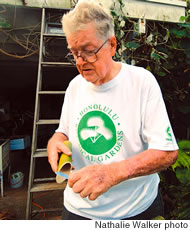Saying ‘Happy New Year’ The Kodomatsu Way
Kadomatsu, a combination of bamboo, pine and flowers, began 600 years ago in Japan as a way of offering luck in the new year, but today it’s more popular in Hawaii than Japan

By .(JavaScript must be enabled to view this email address)
E-mail this story | Print this page | Archive | RSS
says the temple will accept “small kine” kadomatsu wrapped in a plastic bag with salt for ritual burning. “Please do not mix other rubbish in that bag,” he says with a twinkle in his eye. This is not the City & County incinerator or recycling plant.

Binding the three pieces of bamboo
Too often Buddhist temples become collection points for discarded kadomatsu of all sizes, left by parishioners and others who think burning is the only way to dispose of the decoration after new year’s.
Actually, dried out kadomatsu make attractive house decorations. White says many of his students keep them for years. The bamboo color turns from green to yellow or tan, but collectors like them as a year-round omen of good luck. Some use them as a container for fresh flowers.
The ultimate guide to this Japanese tradition is a book titled Spirit and
Symbol: The Japanese New Year by Reiko Mochinaga Brandon and Barbara B. Stephan, published in 1994 for the Honolulu Academy of Arts. The beautiful, full-color volume describes all facets of the Japanese new year celebration, including home and temple decorations, food preparation, and the festive atmosphere that prevails during Japan’s most important holiday.
The authors write, “the fundamental function of the New Year ceremonies is to honor and receive the toshigami (deity), who will then bring a bountiful harvest for farmers and bestow the ancestors’ blessing on everyone.”
With the many blessings we’ve received during the year, including Hawaii’s revitalized economy, it’s a good idea to assure continued good fortune. The kadomatsu and other cultural traditions represent that solidarity known as aloha.

Cutting bamboo, says John White, is
not recommended for beginners
On Monday, Temari ushers in the new year with a Shinto blessing at Ward Warehouse at 10 a.m. Blessing of pet dogs takes place at 11 a.m., followed by dog-and-kadomatsu photo-taking to benefit the Aiea High School Japanese Club.
Interested in making a kadomatsu? Based on public interest, sessions are planned for Wednesday morning at Foster Botanical Gardens in town and Thursday morning at Hoomaluhia Gardens in Kaneohe. Check with the Friends of Honolulu Botanical Gardens, 533-1708.
Page 2 of 2 pages for this story < 1 2
E-mail this story | Print this page | Comments (0) | Archive | RSS
Most Recent Comment(s):








